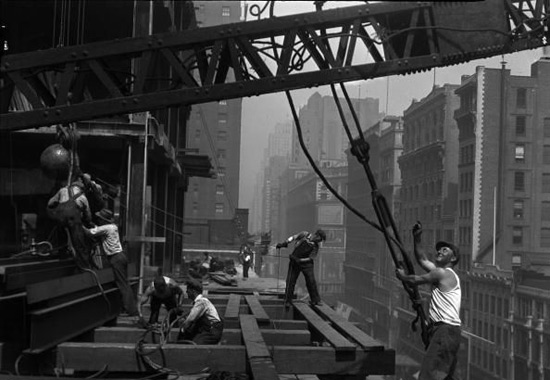Lewis W. Hine (1874-1940), American photographer and sociologist. I am sure many of you are familiar with his work, but perhaps not in name. Since I could not find any mention of him on the forum, I thought that his work perhaps deserved a thread. The b/w photograph he took of the workers sitting on an iron girder high above Manhattan, during the construction of The Empire State Building is probably one of the most reproduced and well-known pictures in history. I had already seen it probably ten years ago, but did not know anything about who the photographer was. Recently got hold of his photojournalist book "Men at Work", and this is an excellent piece if you have a fascination for industrial culture and photography. It contains images of blue-collar workers, construction sites and machines, mainly taken in New York during the early 1900s. And this is the type of journalism that he is most famous for.
The book begins with the following statement:
Quote from: Lewis W. HineTHE SPIRIT OF INDUSTRY
This is a book of Men at Work; men of courage, skill, daring and imagination. Cities do not build themselves, machines cannot make machines, unless back of them are the brains and toil of men. We call this the Machine Age. But the more machines we use the more do we need real men to make and direct them [...] I will take you into the heart of the modern industry where machines and skyscrapers are being made, where the character of the men is being put into the motors, the airplanes, the dynamos upon which the life and happiness of millions of us depend. Then the more you see of modern machines, the more may you, too, respect the men who make them and manipulate them.



There are more, better photographs to be found in the book. These were the best I could find on the internet.
Another thing that his sociological and journalistic work emphasised was the prevention of child labour and photographic documentation of it. A collection of such photos can be found in books such as "Children at Work." I am sure that many feels that this is his most iconic and capturing work. A few examples:


Is anyone else here familiar with his work? or perhaps photojournalists with similar focus? I guess there would be a clear difference in emotion – from the point of the observer (being born long after this era) – when comparing Hine's work to later documentation within the same field. I think the nostalgia, or plain romanticizing of older times – and maybe industrial culture in particular – gives his photography that particular aura.